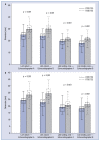Two-dimensional versus three-dimensional transesophageal echocardiography in percutaneous left atrial appendage occlusion
- PMID: 29512094
- PMCID: PMC8083037
- DOI: 10.5603/CJ.a2018.0019
Two-dimensional versus three-dimensional transesophageal echocardiography in percutaneous left atrial appendage occlusion
Abstract
Background: Real-time three-dimensional transesophageal echocardiography (RT3D TEE) enables better visualization of the left atrial appendage (LAA) and may be superior to real-time two-dimensional transesophageal echocardiography (RT2D TEE) for LAA occlusion (LAAO). The aim of this study was to assess inter- and intra-observer variability of RT2D TEE and RT3D TEE measurements of LAA, and to assess the accordance of RT2D TEE and RT3D TEE with appropriate occluder selection.
Methods: Transesophageal echocardiography was performed in 40 patients during LAAO. RT2D TEE and RT3D TEE measurements of the ostium and landing zone were performed independently by two echocardiographers. The appropriate choice of occluder was confirmed with fluoroscopic criteria. After the procedures, RT2D TEE and RT3D TEE evaluation were repeated separately by the same echocardiographers.
Results: The mean ostium diameters by RT2D TEE obtained by the two observers were 23.6 ± 4.2 vs. 24.8 ± 5.2 (p = 0.04), and the mean landing zone diameters were 17.7 ± 4.4 vs. 19.4 ± 3.9 (p < 0.01). In the case of RT3D TEE, the ostium diameters were 29.6 ± 5.3 vs. 29.4 ± 6.4 (p = not significant [NS]) and the landing zone diameters were 21.4 ± 3.8 vs. 21.6 ± 3.9 (p = NS). Intra-observer differences were absent in the case of RT3D TEE. The comparison of RT2D TEE vs. RT3D TEE analyses performed by the same echocardiographer revealed significant differences in the ostium and landing zone measurements (both p < 0.01). Agreement between the suggested device size was better for RT3D TEE (weighted kappa was 0.62 vs. 0.28, respectively).
Conclusions: The results obtained with RT3D TEE showed significantly larger dimensions of the ostium and the landing zone. RT3D TEE showed lesser inter- and intra-observer variability and better agreement with the implanted device.
Keywords: Amplatzer Occluder; left atrial appendage occlusion; real-time two- and three-dimensional transesophageal echocardiography.
Conflict of interest statement
Figures



References
Publication types
MeSH terms
LinkOut - more resources
Full Text Sources
Other Literature Sources
Medical
Miscellaneous
